Visited: Bill Hibbert 31 August 2002
This is a historically very important ring from the Taylor bellfoundry. The tower website used to say: “The bells were cast by John Taylor, Loughborough in 1893, and were only the second ring (after Norton, Sheffield) to be tuned by the ‘Simpson Principle’.” In fact the bells were cast in 1893, and tuned according to the old principles, but not delivered because the tower was not complete. In 1896 the treble was recast and the bells retuned, insofar as was possible, according to the new principles. For how these events fit into the chronology of Taylor’s experiments and developments at this time see the article on Taylor’s history and the description below. The fascination and importance of the bells is that their casting and tuning dates span some of the most important developments in true-harmonic tuning. They are not (all) ‘Simpson’ tuned – to misquote Bill Shankley, they are far more important than that!
St. Tydfil’s church in which the bells are hung was declared redundant in the 1960s and for a while the bells were not rung. However, they have recently been rehung are and now rung regularly. I rang on the bells in April 2009, 7 years after my first visit. Their position, at window-sill height in a stone tower with much space above, means they sound good. I am grateful to Dave Morgan, the tower captain, for allowing me to record and investigate the bells. Andrew Higson, who was then working for Taylors, researched the history of the bells in the foundry records, and I am grateful to him for this work and for his insights into their tuning.
Tuning of main partials
The tuning figures below are those I measured in the tower in August 2002. They agree very closely indeed with the ‘as tuned’ figures from Taylor’s records of 1896, apart from a systematic 4.6 cent difference (which does not affect the tuning intervals) which I ascribe to differences in temperature and / or pitch standards.
Tenor nominal: 690.5Hz
| Bell | Hum | cents | Prime | cents | Tierce | cents | Quint | cents | Nom’l | cents | S’quint | cents | O’nom. | cents |
|---|---|---|---|---|---|---|---|---|---|---|---|---|---|---|
| 1 | 345.7 | -2401 | 690.3 | -1204 | 817.7 | -911 | 1094.8 | -405 | 1383.7 | 1204 | 2059.1 | 688 | 2806.2 | 1224 |
| 2 | 325.6 | -2400 | 589.0 | -1374 | 786.5 | -913 | 973.5 | -504 | 1302.4 | 1100 | 1941.7 | 691 | 2661.0 | 1237 |
| 3 | 288.2 | -2402 | 490.0 | -1483 | 674.6 | -930 | 809.8 | -614 | 1154.3 | 891 | 1731.6 | 702 | 2380.2 | 1253 |
| 4 | 259.2 | -2398 | 461.8 | -1398 | 606.4 | -927 | 741.0 | -580 | 1035.8 | 703 | 1557.5 | 706 | 2149.9 | 1264 |
| 5 | 230.7 | -2398 | 425.5 | -1338 | 546.5 | -905 | 711.5 | -448 | 921.5 | 501 | 1377.6 | 696 | 1898.8 | 1252 |
| 6 | 217.2 | -2395 | 396.2 | -1355 | 509.9 | -918 | 624.5 | -567 | 866.5 | 394 | 1301.2 | 704 | 1796.1 | 1262 |
| 7 | 194.8 | -2393 | 365.5 | -1303 | 462.1 | -897 | 551.1 | -592 | 776.0 | 203 | 1158.3 | 694 | 1591.3 | 1243 |
| 8 | 172.3 | -2402 | 340.7 | -1222 | 412.9 | -889 | 511.1 | -520 | 690.1 | 0 | 1029.8 | 693 | 1417.6 | 1246 |
(The intervals in this table are given in cents. For all partials except the nominal, the partials are given from the nominals of the bell. Cents of the nominals are relative to the tenor.)
The history of the bells
The following information was provided by Andrew Higson: These bells were cast by Taylors in 1893. They were tuned on the old tuning machine which was only capable of cutting the soundbow, as the toolpost rotated and the bell stayed still. They were tuned in the key of F in old church pitch (i.e. C = 524 Hz) to which the forks in use at the time were tuned. The sixth was a maiden bell after this first tuning.
Correspondence between John Taylor and the church indicated that the tower was not complete and so the bells were stored until the building work was completed. In the interim, Taylors began true-harmonic tuning, so they decided to have a more scientific go at tuning the bells. The treble was tuned in September 1895 as an experiment to see what could be achieved. The results were clearly unsatisfactory as the treble was recast (at the second attempt) on August 29th 1896 to be tuned harmonically. The remaining bells were retuned during September or October 1896 to get the best out of them that was considered possible. It looks as if (says ADH) they tuned the tenor to get that reasonably well in tune and then altered the rest to suit. It was a good effort to get all the hums so close to unison.
The historical importance of these bells is demonstrated by fitting their casting and tuning dates into a timeline of Taylor’s and Simpson’s activities, as follows:
- in 1890, Lord Rayleigh published the results of his research into bell acoustics
- In 1893, bells two to seven of this peal were cast
- in about 1894, Taylors purchased a set of forks in 4 Hz steps from 340 to 540 Hz
- in 1894, Canon Simpson first wrote to Taylors to explain his ideas
- in the mid-1890s, Taylors established a tuning shop and purchased a full set of forks
- by May 1895, Taylors were routinely recording the figures for hum, prime, tierce and nominal in their tuning books
- in September 1895, Taylors attempted to retune the treble cast in 1893
- in autumn 1895, Simpson published his first paper
- in February 1896, Taylors took delivery of a new tuning machine
- in August 1896 the treble was recast
- in September / October 1896 the bells were retuned
- in autumn 1896, Simpson published his second paper.
The profiles of the bells
The chart below shows the external profiles of all the bells, normalised to the same mouth radius. The chart plots the following points on each bell: A is the rim, B is the corner of the shoulder, C is the vertical axis through the centre of the bell, and D is an estimated position for the top of the crown.
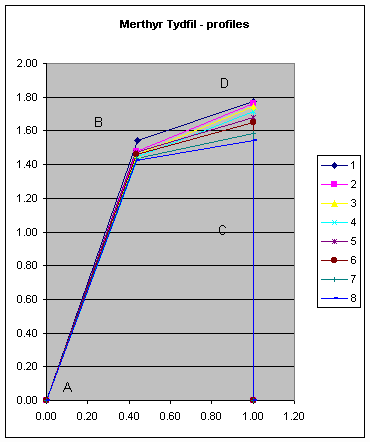
Seven and eight have quite flat crowns. Two, three and four have high crowns. The recast treble is significantly taller to the shoulder than any of the other bells. The treble has a flat crown compared with the three bells beneath it.
These differences in profile show clearly in photographs of the bells. The pictures below are of the treble, the third and the seventh (the tenor is in the middle of the frame and hard to photograph). The high, domed crown of the third is very typical of Taylor trebles of the late 19th century before they perfected their true-harmonic profiles – the 1892 trebles at The Queen’s Tower have just such shapes. The tenors in contrast have a flat crown and angular shoulders, again quite typical of Taylor tenors of the period. The difference in shape is probably for mechanical reasons, to make the lighter and heavier bells easier to strike together.
The treble, with its crown rather flatter than the third, demonstrates the changes in profile devised by Taylors to permit true-harmonic tuning.
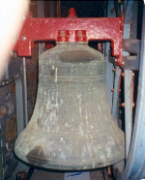 | 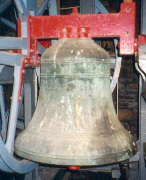 | 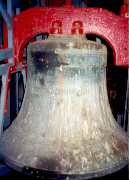 |
| Treble | Third | Seventh |
The primes in the bells get flatter (i.e. worse) as the bells get smaller, except for the treble, which was of course recast. The plot below shows, in red, an estimate of the ratio of crown height to shoulder height for each bell, and in blue, the flatness of the prime (prime cents – 1200) / 1200. Though there is much more to prime tuning than external crown height, these two plots show an interesting correlation.
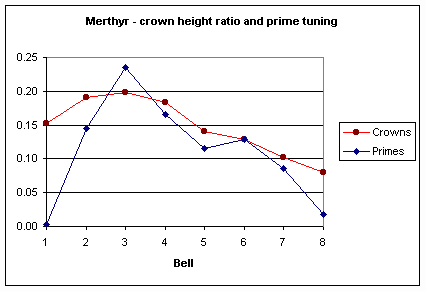
Tuning
Andrew Higson was able to find for me complete details of the retuning of these bells in 1895. The figures in the record books include the before figures (i.e. the result of the tuning done in 1893), target figures for the 1896 retuning, and the frequencies actually achieved on the tuning machine. It is illuminating to distinguish in the final tuning of the bells the contributions of 1893 bell profiles and 1896 tuning. There are practical limits to what can be achieved on the tuning machine, as follows:
- nominals, within reason, can be controlled at will by the tuner
- hums can be tuned to some degree, but to get them down all the way from the old-style seventh to the true-harmonic octave requires a change in bell shape
- primes can be flattened on the tuning machine (especially by tuning inside the shoulder) but cannot be significantly sharpened
- the tuner has little control over the tierces; once the other partials have been tuned the tierce tuning is controlled overwhelmingly by the bell shape, especially the soundbow.
With this as background, we can investigate the tuning of these bells. First, here’s an overview of the 1893 tuning:
Tenor nominal: 710Hz
| Bell | Hum | Prime | Tierce | Nominal |
|---|---|---|---|---|
| treble | -2332 | -1369 | – | 1222 |
| second | -2324 | -1373 | -898 | 1105 |
| third | -2293 | -1462 | -903 | 903 |
| fourth | -2277 | -1353 | -893 | 697 |
| fifth | -2301 | -1320 | -882 | 508 |
| sixth | -2330 | -1331 | -903 | 393 |
| seventh | -2324 | -1321 | -881 | 207 |
| tenor | -2347 | -1230 | -876 | 0 |
What we see here is a very typical Taylor old-style ring of the period, tuned with Just nominals, and about 20 cents of stretch spread evenly across the octave. The primes are rather flat in the smaller bells, a feature of the old-style profiles. The hums in the back three, the treble and the second are quite good, the rest are sharpish. The tierces wander about somewhat.
In the following table are the complete tuning figures from the 1896 retune: before tuning (i.e. the 1893 figures above), the target figures, and actually reached on the tuning machine. We also have the figures for the old 1893 treble, which was tuned but not judged satisfactory and therefore recast. The target tuning figures represent a true-harmonic peal tuned with Just nominals and no stretch. The figures are in Hz (cycles per second), not cents:
| Bell | Hum | Prime | Tierce | Nom’l |
|---|---|---|---|---|
| Old treble, before | 374 | 652 | – | 1438 |
| Old treble, target | 346 | 692 | – | 1384 |
| Old treble, after | 348.5 | – | – | 1393 |
| New treble, before | 381 | 783 | – | 1485 |
| New treble, target | 346 | 692 | – | 1384 |
| New treble, after | 347 | 692 | 821 | 1387 |
| Second, before | 351 | 608 | 800 | 1344 |
| Second, target | 324.3 | 648.7 | – | 1297.5 |
| Second, after | 326.5 | – | 773 | 1306 |
| Third, before | 318 | 514 | 710 | 1196 |
| Third, target | 288.3 | 576.6 | – | 1153.3 |
| Third, after | 289.25 | – | 677 | 1158.5 |
| Fourth, before | 285 | 486 | 634 | 1062 |
| Fourth, target | 259.5 | 519 | – | 1038 |
| Fourth, after | 260 | – | 608 | 1039.25 |
| Fifth, before | 252 | 444 | 572 | 952 |
| Fifth, target | 230.6 | 461.3 | – | 922.6 |
| Fifth, after | 231.5 | – | 549 | 925 |
| Sixth, before | 232 | 413 | 529 | 891 |
| Sixth, target | 216.25 | 432.5 | – | 865 |
| Sixth, after | 217.75 | – | 512 | 869 |
| Seventh, before | 209 | 373 | 481 | 800 |
| Seventh, target | 194.625 | 389.25 | – | 778.5 |
| Seventh, after | 195 | – | 463 | 779.5 |
| Tenor, before | 183 | 349 | 428 | 710 |
| Tenor, target | 173 | 346 | – | 692 |
| Tenor, after | 173 | 341 | 414 | 692 |
The tuner set target values for the primes but did not record them after tuning, realising, perhaps, that it would not be possible to tune them true-harmonic (except in the new treble) because they were already too flat. The target and achieved figures for nominals and hums are close in all the bells. Clearly, the tuner knew how to achieve octave hums from the 1893 profiles, even in the old treble, whose hum was tuned to an exact double octave when tuned in September 1895. In general it is not possible to achieve octave hums in the retuning of old-style bells. This is a strong indication that Taylors had already begun to change their profiles by 1893 to improve the hums, though tuning them to the exact values awaited both a better tuning machine and full understanding of how to achieve the desired result.
No targets were set for the tierces, a recognition I think by the tuner that he would have no control over these partials. Taylor’s design for tierces continued to develop, attributable in the main (I am told) to the shape of the soundbow. From the mid 1890s until at least the 1920s, Taylors cast their bells with 884 cent of Just tierces. Later, they adopted equal tempered or 900 cent tierces, driven no doubt by the preference of their carillon customers.
When I went to record the bells I was able to inspect the tuning marks within each. The marks extend from the middle of the lip to a few inches below the shoulder in every case, clearly visible despite a layer of corrosion. The tuning is carefully executed with no ridges or sudden changes in profile. None of the bells has been tuned in the shoulder.
The difference in sound between the treble and third, mostly due to prime tuning, is quite obvious.
The significance of the Merthyr bells
Due to the unique and happy circumstance of the delayed delivery of these bells, we have a record, frozen in bronze, of the work Taylors were doing to develop true-harmonic profiles and tuning. One can speculate that in 1893 Taylors had already begun to experiment with a profile that could be tuned to a true-harmonic hum, as they showed with the treble in September 1895. Between 1893 and 1896 they discovered how to cast a bell that could be tuned with an octave prime. In 1896, though, they had not yet conquered the tierce, based on the evidence of one bell, the replacement treble of this peal.
There has long been speculation as to the origins of Taylor’s true-harmonic tuning, and the contribution made by Canon Simpson. Did the developments start with Simpson’s letter in 1894, or were they already underway? Tradition has it that Taylors had already begun the experiments and profile modifications which resulted in the new tuning style, based on information gained by studying continental bells. Certainly, this tradition is supported by these bells, though not absolutely confirmed. What is certain is that Simpson, at least in his published work, tells nothing of the detailed changes in profile that Taylors were developing. Either he was not aware of these, or agreed with Taylors not to publish their secrets.
Andrew Higson did considerable research in Taylor’s records to help with this analysis, and I am most grateful to him. Errors and unsubstantiated opinions are of course my own.